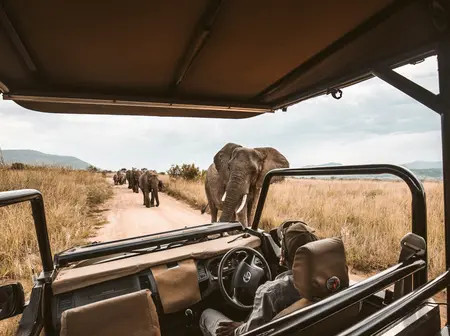Uber’s move into safari bookings did not arrive with fanfare. It appeared quietly inside its standard ride-hailing app — wedged between everyday transport options — as if a game drive were no more unusual than a trip to the supermarket. Yet the implications of Uber Safaris are anything but subtle. By integrating national park excursions directly into a global mobility platform, Uber effectively reframed wildlife tourism not as a luxury outing but as an on-demand logistical service. What once required coordination with tour operators, advance deposits and phone-based negotiations can now be scheduled through the same interface used for airport runs.
Now Bolt, Uber’s most persistent rival across African cities, is preparing to challenge that position. The company has confirmed plans to enter the Kenyan safari market by late 2025, hinting at pricing that could undercut Uber’s rates. While few operational details have been disclosed — no list of partner parks, no confirmed vehicle specifications — one strategic intent is already clear: Bolt wants to anchor itself as the cheaper gateway into national park experiences. That positioning sets the stage for the first true safari booking battle between Bolt and Uber in Kenya, and unlike previous ride-hailing contests centred on urban mobility, this one will unfold across protected ecosystems rather than city streets.
Uber’s approach is intentionally conservative. It does not own safari vehicles, nor does it employ rangers. Instead, it acts as a digital access layer over pre-existing tour infrastructure, relying on licensed operators with extended-wheelbase Land Cruisers and trained guides. Every booking still begins and ends at a customer’s home, but the structure beneath it remains familiar to the conservation sector: compliance, certification and close coordination with authorities such as Kenya Wildlife Service and the Tourism Regulatory Authority.
Bolt is unlikely to replicate that model in full. Historically, the company has pursued growth by onboarding partners faster and tolerating thinner margins for longer. If Uber curated a limited pool of established safari firms, Bolt could open the gate to smaller operators who currently lack formal marketing visibility. That would widen participation but also introduce questions over standards, safety protocols and vehicle suitability. The Land Cruiser is not an aesthetic choice; it is built to withstand unpredictable terrain and unpredictable animals. The temptation to swap it for a standard SUV in the name of cost reduction will be strong.
The safari has long been positioned as a deliberate experience rather than a casual outing. It is normally planned days in advance, prefaced by safety briefings and guided by strict environmental etiquette. A booking platform, by contrast, flattens that ritual into interface logic: trip accepted, driver en route, estimated arrival in fourteen minutes. That shift carries cultural implications. What happens when a lion sighting becomes just another transactional output — no different from a driver arriving five minutes early?
Yet to insist that traditionalism must be preserved untouched is to ignore how exclusionary the system has been. Many Kenyans have never entered a national park, not because of lack of interest but because the booking process felt opaque and financially inaccessible. If Bolt succeeds in lowering these barriers further, wildlife access may finally become routine for local families rather than aspirational. The concern, however, is whether affordability will be achieved through efficiency or extraction.
Both companies will promote this competition as a win for accessibility, but any decrease in consumer pricing must be offset elsewhere. If platforms absorb the cost, they will demand volume. If operators absorb it, services may thin out at the edges — fewer guides, fewer maintenance checks, less flexibility during peak demand. The risk is not immediate collapse but gradual erosion of quality until the safari becomes indistinguishable from a standard road trip with animals as roadside scenery.
A more complex outcome is also possible. Tour operators may retain their place within the system while losing brand visibility, becoming silent providers beneath platform branding. Park authorities may respond by revising levies or limiting daily digital bookings to protect environmental load. Or the platforms themselves may begin experimenting with dynamic pricing — peak-hour surcharges tied to animal activity rather than traffic congestion. That may sound speculative, but algorithmic thinking rarely stops at polite boundaries.
Neither Bolt nor Uber is chasing the safari market for prestige alone. What they want is ownership of the interface through which travellers — both domestic and international — make their purchasing decisions. The company that becomes the default starting point for wildlife excursions will control not only transport fees but ancillary revenue streams: scenic route upgrades, bundled picnic packages, photo licensing, even post-drive digital souvenirs. Once a user gets used to tapping a phone instead of emailing a tour company, behavioural loyalty shifts permanently.
This raises a strategic question: if platform dominance grows too quickly, will Kenya Wildlife Service and related agencies remain passive facilitators — or will they attempt to build a competing state-run booking system? The digitalisation of access cuts both ways. What the private sector can streamline, the public sector can eventually replicate.
The safari booking battle between Bolt and Uber in Kenya will not be won through advertising or app features. It will be settled on three fronts: public trust, operator alignment and ecological impact. If either company can maintain efficiency without trivialising the experience or destabilising park ecosystems, this could become a model for how technology integrates with conservation economies. If they fail — if wildlife encounters begin to resemble low-cost adventure rides — the backlash will be swift, and likely led by the very institutions that initially endorsed their entry.
Kenya has a chance to demonstrate that modernisation and stewardship need not be opposing forces. But it will require more than platform ambition; it will demand clear standards, consistent oversight and a willingness to recognise that not all forms of convenience are progress. In a landscape where lions do not leave customer ratings, responsibility falls on the humans behind the code.

Leave a Reply